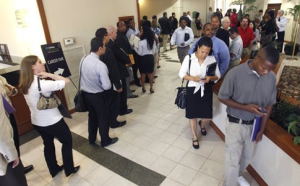Job Growth Disappoints
 Courtesy of CNBC by Jeff Cox. Job creation stumbled in December, with the economy adding just 74,000 positions even as the Federal Reserve voted to take the first steps in eliminating its stimulus program.
Courtesy of CNBC by Jeff Cox. Job creation stumbled in December, with the economy adding just 74,000 positions even as the Federal Reserve voted to take the first steps in eliminating its stimulus program.
The unemployment rate dropped to 6.7 percent, below economist estimates and due primarily to continued shrinkage in the labor force. The labor force participation rate tumbled to 62.8 percent, its worst level since January 1978.
The monthly job creation was the worst in nearly three years and well below the upwardly revised 241,000 in November.
Economists had expected the economy to add 200,000 jobs in December, with the unemployment rate holding steady at 7.0 percent.
A broader measure of unemployment that includes discouraged and underemployed workers held steady at 13.1 percent.
Fed policy has been contingent on two factors—a declining unemployment rate and low inflation. The central bank in December voted to cut its monthly quantitative easing program by $10 billion to $75 billion a month. Chairman Ben Bernanke has said that a 7.0 percent unemployment rate would serve as a rough guidepost for cutting the asset purchases, while 6.5 percent would be a benchmark for when to consider raising rates.
The numbers immediately sparked debate over whether the Fed would continue to pare back or reconsider. The data indeed have been stronger, with ADP reporting private job growth in December at 238,000. Weekly jobless claims have been consistently below 350,000 and Institute for Supply Management indicators also have pointed to stronger hiring. But the combination of a declining labor force and a structural unemployment issue in which employers are reluctant to add jobs has made the labor dynamic more difficult to decipher, both for the markets and the Fed.
“The discrepancy in the skills gap is huge,” said Tom Gimbel, CEO and president of LaSalle Network, a Chicago-based staffing firm. “I’m dealing with a thousand companies in Chicago and a few outside of Chicago that are looking to hire people and the skills are not there.”
Professional and business services added 19,000 while manufacturing grew 9,000.
Category: General Update










